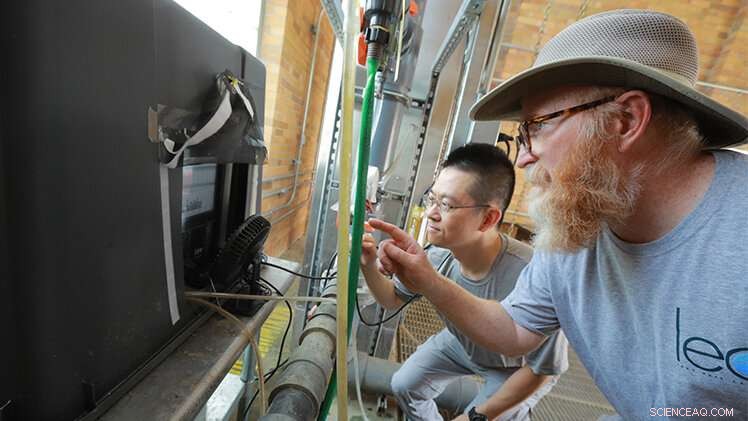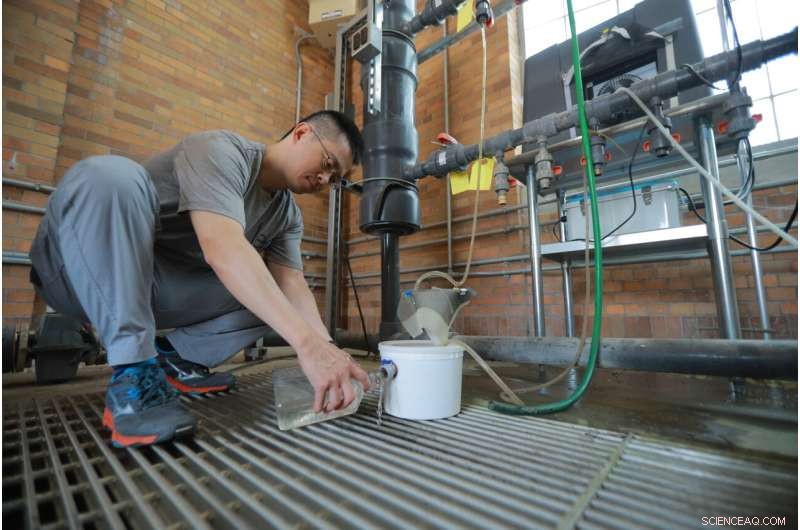
Dr. Thomas Bridgeman, professor i ekologi och chef för UToledo Lake Erie Center, till höger, och Dr. Kuo-Pei Tsai, en postdoktorand forskningsassistent, läste data som kommer från online-algövervakningssystemet som testas i stadens råvatten pumpstation för att skydda den allmänna dricksvattenförsörjningen under den skadliga algblomningssäsongen. Kredit:Daniel Miller, University of Toledo
Eftersom fara hägrar i vattendrag globalt där giftiga alger blommar, kan en liten förvaringsbalja av plast i Toledo som är förseglad för att skydda mot stänk, spindlar och fågelavföring innehålla en ny teknik i kampen mot det växande miljöproblemet.
Algforskare vid University of Toledo testar en optisk sensor i realtid vid Toledo Water Treatment Plant som en del av dess källvattenövervakning för att skydda den offentliga dricksvattenförsörjningen under den skadliga algblomningssäsongen.
Var 15:e minut tar enheten en klunk av Lake Erie-vatten som kommer in i anläggningen, läser provet och lägger ut mätdata online så att forskare och vattenverkschefer kan nås på distans.
Dess största värde är förmågan att avgöra om små encelliga organismer kända som cyanobakterier som utgör skadliga algblomningar i Lake Erie är ömtåliga och börjar bryta upp. Om cellerna bryts upp frigör de gift. Upplöst toxin är mer utmanande för vattenreningsverk att ta bort eftersom det kan passera genom filter och måste avlägsnas på kemisk väg innan vattnet lämnar anläggningen till våra kranar.
Sedan juli har UToledo-forskare kontrollerat enhetens ledningar och slangar för att se till att den fungerar korrekt. De gör också laboratorieexperiment vid UToledo Lake Erie Center som visar att tekniken fungerar som den förväntas.
"Vårt arbete i sommar med PhycoSens-enheten är det första testet av detta online-algövervakningssystem vid en dricksvattenanläggning i USA", säger Dr Thomas Bridgeman, professor i ekologi och chef för UToledo Lake Erie Center. "Om vi visar framgång vid Toledo Water Treatment Plant och i hela regionen för att omedelbart upptäcka och meddela om toxinutsläpp, så kan det skalas upp över hela landet. Hittills har det lovat mycket."
Testinstallationen av det avancerade övervakningssensorsystemet är en del av ett UToledo-projekt på 1,4 miljoner dollar som finansierats av U.S. Army Corps of Engineers som började för mer än ett år sedan och fokuserar på tidig upptäckt och hantering av skadliga algblomningar.
Sedan vattenkrisen i Toledo 2014 lämnade en halv miljon invånare utan säkert kranvatten i tre dagar, har forskarna större klarhet i att det inte bara är storleken och utseendet på algblomningen som spelar roll, utan vad som händer i cellerna.
Bridgemans enheter tillverkade av det tyska företaget bbe Moldaenke använder optiska sensorer för att i realtid mäta hur mycket och vilken sorts alger som kommer in i vattenreningsverket, inklusive cyanobakterier. Ännu viktigare är att sensorerna kan ge en varning om att cyanobakteriecellerna bryts upp och läcker ut sitt innehåll, inklusive eventuella gifter som de kan innehålla, i vattnet.
"A large release of toxin can happen in a matter of hours, and it is critical for water plant operators to have this information so they can adjust their treatment levels quickly, before dissolved toxin can get through the plant," Bridgeman said. "The data are produced every few minutes, which makes it a useful early warning tool for a potentially rapidly changing algal situation."
Notable for researchers is data collected in late July showing the peak of the bloom and its decline.
"So far we have not detected any of that cell breakage at the water treatment plant or near the water intake out in the lake using the automated sensor, which is good news," Bridgeman said. "However, UToledo crews on our research vessel taking water samples out in the lake throughout Lake Erie's western basin—not near the water intake—have detected cell breakage using the manual version of the same device this season."
Bridgeman said that cell breakage events leading to large releases of dissolved toxin don't happen every year in Lake Erie.

Dr. Kuo-Pei Tsai, a post-doctoral research associate at the UToledo Lake Erie Center, works at the city's raw water pump station with the plastic storage tub containing a game-changing technology in the fight against toxic algae. Credit:Daniel Miller, The University of Toledo
"It happened in 2019 and possibly in 2014 but not to a large extent this summer, at least not near the water treatment plant's water intake out in the lake," Bridgeman said.
The Toledo Water Treatment Plant's laboratory makes the most use of the data.
"The experimental optical sensors being tested at the raw water pump station are a useful source for both the changes and the severity of algae levels coming from the lake," said Jeff Martin, chief chemist at the Toledo Water Treatment Plant. "We didn't have remote access to the data until part of the way through the bloom season due to computer issues, but since then it has been a welcome tool in treatment decisions."
Bridgeman has studied harmful algal blooms for two decades. His laboratory is one of the key locations for tracking and providing early warning of harmful algal blooms in the western basin of Lake Erie.
He said while the new instruments can detect the health, or physiological condition, of the cyanobacteria, they do not provide actual toxin readings, making them a supplemental weapon in a water utility manager's arsenal to efficiently and economically adjust treatment to maintain drinking water safety.
"Measuring toxin still requires a separate, fairly time-consuming test," Bridgeman said. "Therefore, the fast optical measurements will be coordinated with slower chemical toxin measurements to provide a complete picture of what is happening in the lake water that is entering the water plant."
The device will be removed from the water treatment plant for analysis in October and then his team will study the results and potentially put it back in the plant next summer.
Bridgeman's device monitoring tests are one part of a larger, wide-ranging project funded by the U.S. Army Corps of Engineers that also includes faculty in the UToledo College of Engineering.
Dr. Youngwoo Seo, professor of civil and environmental engineering and chemical engineering, leads the three-year project to improve water quality from the source to the tap.
Some of the technology and techniques being tested by UToledo are new to water treatment plants in the western hemisphere.
The project features two different parts working together:
Dr. Dae-Wook Kang, assistant professor of civil and environmental engineering, leads a molecular approach to develop a robust detection method, and his analysis will help better understand what triggers the toxin gene production of cyanobacteria.
Seo is focused on mitigation and the treatment method for toxin removal. His laboratory is working on the biological degradation of cyanobacteria and their toxins using the naturally occurring bacteria and viruses from the lake and NSF-approved chemical treatments. + Utforska vidare